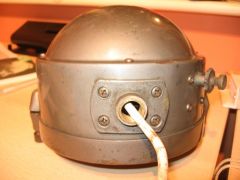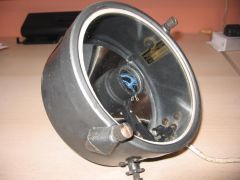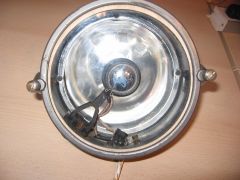-
Posts
5,437 -
Joined
-
Days Won
4
Content Type
Profiles
Forums
Events
Gallery
Blogs
Store
Everything posted by Proper Job
-
I know this topics been covered before, but you can never find the thread when you want it! Search 'paint' - you'll be there all night sifting through the results! What recommendations do folks have for engine paint? I need to paint inside the crankcase, timing covers and sump (enamel?). The existing surface appears to be a red lead colour, but I'm sure its not red lead. Obviously it will come in to constant contact with oil. What recomendations do folk have for external engine paint (I'm thinking a dark green or dark blue)? Is it best to stick to the same manufacturer for primer, undercoat and top coat?
-
Tim Thanks for your advice. Apparently the engine was used to drive variable speed shafting arrangements in a mill to lift corn/flour bags etc. Russell Newbery do not recognise the governer. Most RN marine units are horizontal ones, whilst mine is vertical. I'm hoping that the cam units that adjust the speed/spring resistance on the governer may give sufficient adjustment. RN have the alternative goverers available (at a cost) if needed. Time will tell(?). In the mean time, if you can rake back through your memory for anything else that may help, I'd be obliged
-
I know its not a 'boat build' blog, but its the start of that process. Having just recently obtained a National D3 Industrial engine via ebay, I have started a blog that will follow the rebuild and marinisation of the engine. Eventually it will be fitted in to a 62' tug hull. For anyone interested, its at http://d3national.blogspot.com/ If anyone else is interested, I have two 1941 Ailsa Craig RFR4's (40hp @ 1200 rpm) that I will be selling in the new year. I was about to start work on them but the National is now taking priority (and all spare cash!). Send me a PM if you would like to see them.
-
Got to agree with Malc here. A classic case of cavitation. It is a usual problem with inexperienced boat handlers. They need to stop quickly, apply loads of rev's, and all the prop does is thrash around in air. In an emergency situation, it takes a bit of courage/experience to know that putting in to reverse and gently applying throttle will actual stop you quicker. The slightest sign of excessive vibration or 'foam' issuing out from the counter is a sure sign of cavitation. Drop the rev's back down, let the prop bite and it will stop you quicker. It is a trait with modern engines that can go from ahead to full astern very quickly. Older 'vintage' engines that take time to run down to tickover, change gear and then run back up to speed tend to do it in a natural time scale. Them big, heavy flywheels do the trick!
-

Attaching a new centre rope eye
Proper Job replied to blackrose's topic in Boat Building & Maintenance
Your 12 tonne eyebolt is only at 25% load capacity (3 tonnes) when your 6 tonne rope is stopping your boat heading for the wier! That assuming it is fitted (ie threaded) as per the manufacturer instructions. Do you see where I'm coming from? Sorry to keep banging on about this but I've seen some results of nasty accident involving the miss-use of lifting equipment (which is what an eyebolt is). -

Attaching a new centre rope eye
Proper Job replied to blackrose's topic in Boat Building & Maintenance
I've just edited my post above that may give some additional info on load capacities. I hear what your saying about a lot of builders weld eyebolts on. A lot of builders do a lot of things in ignorance. Its just a simple cheap solution to them. We, the buying public, are also ignorant of the facts and it looks like a professional job. Ask an eyebolt manufacturer what gaurantee's they'd put on their product if they knew it had been welded to a roof and used in such a way as we all often do with a centre rope. I think there answer would be zero! You would be better off with a mild steel 'U' bolt through the roof than a welded eyebolt. The former will deform (bend) before giving up. The welded eyebolt will just go bang! -
The call it a 'ping' after the 'asdic' used for hunting subs. They send out a ping and see if its reflected back. That's exactly what your doing when you 'ping' a web site/address. Ping it - see if something is there. If it is it pings back! Clever these sub-mariners!
-

Attaching a new centre rope eye
Proper Job replied to blackrose's topic in Boat Building & Maintenance
Tim A good practical test that shows the merits of differing fittings. One thing that should never be done to eyebolts is welding them. The heat generated by welding can seriously enbrittle the forged steel that they are made from (either mild or stainless). Ask any lifting equipment inspector. Your 'preferred' method could still be used, but I would suggest a 6 - 10mm plate secured to the (4mm?) roof using your counter sunk screw method and the both the plate and roof drilled and tapped to match the thread of the eyebolt. Use the primary tap only to get a good fit on the thread and shim with washers to obtain the correct orientation on the roof. Additionally, if megga load is placed on the eyebolt it will twist on the thread to the correct angle to take the load (it should never be side loaded). The loads placed on these eyebolts by a 10+ tonne boat are astronomical. I would only use a fairly 'thin' rope as well. You want the rope to break (as in your test) well before the eyebolt fails. The energy stored in a streched rope would fire it at the person at the other end of the rope with potentially fatal consequences. Please be careful people. Added: I've just dug out my old engineering books to confirm a couple of figures. Using 'Shoulder Type Machinary Eyebolts' (don't use non shoulder types). The rated load is only when the load applied is in direct line with the eyebolt. When connected to your roof this means straight up. With the applied load at 45 degrees the load capacity reduces to 30% of the full load. At 90 degrees (tied to a bollard?) this is reduced to 25% of the rated capacity. An eye bolt should never be loaded at any angle other than in line with the eyebolt. How often are they side loaded when on the roof of a NB? Virtually all of the time? The web site below has some good info on load capacities http://www.boltdepot.com/fastener-informat...oad-Limits.aspx -
I don't want to highjack the topic but while we're on Calorifiers. What is peoples experience in the 'horizontal' cal's. How efficient are they? I know a vertical cylinder with the primary heating coil at the bottom will heat virtually all of the tank and induce a lot of convection (I think that's the right one) in the water. With a horizontal one, they appear to have the primary coil laying along the centreline of the cal (therefore half way up of what is not a great deal of hight). Do they work as well? I was thinking about putting one under the double bed in the dead space behind the drawers. It may be a little warm in the summer? But a nice under blanket heating in the winter!
-
I have some real fond memories of Battersea. Back in the early 80's she was a trip boat on the river Thames based at Radcot. She was the first 70' working boat I ever helmed. She was a bit of a handful around some of the bends below Buscot! It was amusing to see the faces of people coming the other way when they met you on a bend. - Happy Days! Was owned by a bloke call Chris (if my memory serves me well). I don't think he ever made any money, it was more of just a hobby. I for one, am glad to see she's still going strong.
-
Our next door neighbour torched a mower (by accident) when filling it up with petrol. Fuel dripped on to the exhaust manifold – whoosh! Luckily he was not hurt. The mower was totalled. Why not get a diesel genny. You can get really small ones now. Bl##dy site safer.
-
From the album: Odds and Sods
-
From the album: Odds and Sods
-
The man in the street will never beat both the governments of the day (they're all as bad as each other) and the commercial market place. I work in an industry very closely connected to all of the oil majors and the exploration/assessment of oil reserves business. The recent price rises are nothing to do with 'oil running out'. Its purely economics. Our american freinds are in the Sh1t. The storms in the gulf of mexico serverly damaged their 'local' oil industry. As such, they a) ran down reserves (consumption remain constant but supply was reduced), b ) have now had to buy more on the global market place to meet the short fall, hence pushing up the price as OPEC has not increased production. The price of a barrel has sky rocketed on the global market due to the americans topping up their reserves. The price at the pumps has had a double wammy because, along with this market increase, it co-incided with a tax increase. The result is a big hike at the pumps. The biggest benifactor of the price of a barrel of oil is the government. Yes, the oil industry does make profits, but they do pail in to insignificance compared to UK PLC LTD. That said, high cost does focus the mind on waste. Spend some time in the states (I have). The wastage over there beggars belief. The reason - as part of the percentage of income, energy is very cheap! I'm off me soap box now.
-
Snibble and Richard are right (if it is nothing obvious) I've had the same syptoms to a greater or lesser degree. Took me ages to work it out. My theory is: when the prop is turning the leaves wrap around the leading edge of the blade. If you stop the prop turning they don't have a force pushing them on to the prop blade and they drift away (often unseen). By the time you open the weed hatch their gone. A quick blip astern (or even just neutral) and everything is fine.
-
Chris Electric forklifts are often fitted with these type of devices. Surely it could be adapted? There a bit like these garden irrigation systems.
-
I'm sure I remember reading about a waste recycling place being built alongside the GU down London way. Can anyone expand? The original plan was to move as much as possible by water. I wonder how much actually goes this way in the end.
-
I can only concurr with John O and Catweasel. On a previous boat we had a stove at the front corner. The only way you could have the front doors open was if the cratch covers were down. Half way up the lounge or at the opposite end to the front doors. If smoke blows in through a window you can close it and still have others open. Even when its cold, you can get so hot inside that you have to open a door/hatch. Mmmm... loverly and toasty.
-
Its all about supply and demand I suppose. I hope that dosen't mean the cost of me Fish & Chips is going up! It also fair to say that (and I have this on good authority) that scare mongers who keep going on about oil running out are just that - scare mongers. The good news is: The human race has, to date, used less than 10% of the known oil reserves in the world (and there finding more all the time). The bad news is: we're using the easy to get to (therefore cheap) stuff. But, as the price for oil goes up, more reserves become economical to extract and process.
-
Generally, I think that the Stationary Engine and Marine Engine fraternity rarely meet in conflict. Most of the SE engines are small horse power (yes, I know there are exceptions) and mostly petrol. The logistics of lumping around Vintage Marine engines, often over 500kg usually procludes them. Especially when there's plently of interesting small stuff around. There are some cross overs in the industrial generator world, but in fairness, a lot of these 'statinary' engines have been marinised by us boaty boys! An engine doing what its been designed for is great. An engine pumping blue water around a tank is better than to have lost the engine completely. If it wasn't for the stationary engine boys a lot of this history would be gone for good. Long may we all carry on side by side. Has anyone ever put a large open crank unit in a NB? A big Roby or Tangyes. That would be an interesting project! I wouldn't mind this wee Gardner: http://enginemuseum.org/gallery/displayima...um=3&pos=18
-

boat draft...0.91m...avoid canals or not????
Proper Job replied to philandiz's topic in General Boating
Panama's at a slight disadvantage cos of the locks. I'm trying to think of lock free UK canals but they grey matter has stalled. Not un-common at the moment. Of course, bridge width and other obsticals may also come in to play -
What actually defines a 'narrowboat engine' or a 'vintage engine'. Many 'vintage' engines being fitted today were never 'original' fits in NB's. NB's and their engines have always evolved over the years. How many original horse drawn boats were converted in to motors? Not original fits? Operates were notorious for changing engines and upgrading their boats. Thats the way of the world and always will be. Did any NB's ever get fitting with Kelvins from 'new'? Not that I'm aware of (i'm now doning the flak jacket ready to be corrected). Yet Kelvins were more used in marine applications that industrial. Ailsa Craigs were (retro?) fitted to NB's. RF2's certainly. My RFR4 was built in 1943 but they were never (to my knowledge) fitted in 'original' NB's, but I like to think of it as being a 'vintage marine engine'. Note the 'marine' bit. Does and ex' gen set count cos it never left the factory as a true 'marine' engine? Far as I'm concerned, if looks good, sounds right, does the job, who cares. If the owners happy thats all that matters So what actually is a vintage NB engine? Who dares to define it?
-
If you want to see something really big: http://people.bath.ac.uk/ccsshb/12cyl/ Back in my seafaring days the biggest I worked on was a 32,00hp@110rpm. This really is a big un! They all run on 3500 sec heavy residual fuel oil (the crap thats left over from the refining/cracking process). Its cheap, but if your burning 1,660 gallons per hour, it has to be!
-
The fuel was named after the engines that it powered, which was named after the person who (allegedly milord) invented the engine. Basically, any engine that ran on the compression ignition cycle, which usually used 35 sec grade fuel (or there abouts) was a 'diesel'. A bit like a Hoover. The boss has an Electrolux. I call it a Hoover. Really its a vacuum or suction cleaner. Regarding fuel pumps. Most modern fuel pumps work on very tight clearances (metal to metal faces - usually chrome). They rely on the fuel to lubricate them. A diesel molecule is a lot smaller than a vegetable oil molecule and therefore fits in the minimal clearance. If you use VO on this type of pump the VO molecule cannot fit in the gap, the plungers/vanes etc are not lubricated and they fail. The busses around us VO. Sit behind one in a traffic jam. The smell! My old Ailsa Craig RFR4 could run on VO but I don’t think I could stand the smell, especially with it exhausting out of the roof. By the way - put a bottle of VO in some iced water and see how well it comes out after a hours or so. Thats what would happen to it in your tank/fuel lines and injectors unless you mix it with something else (see above)




